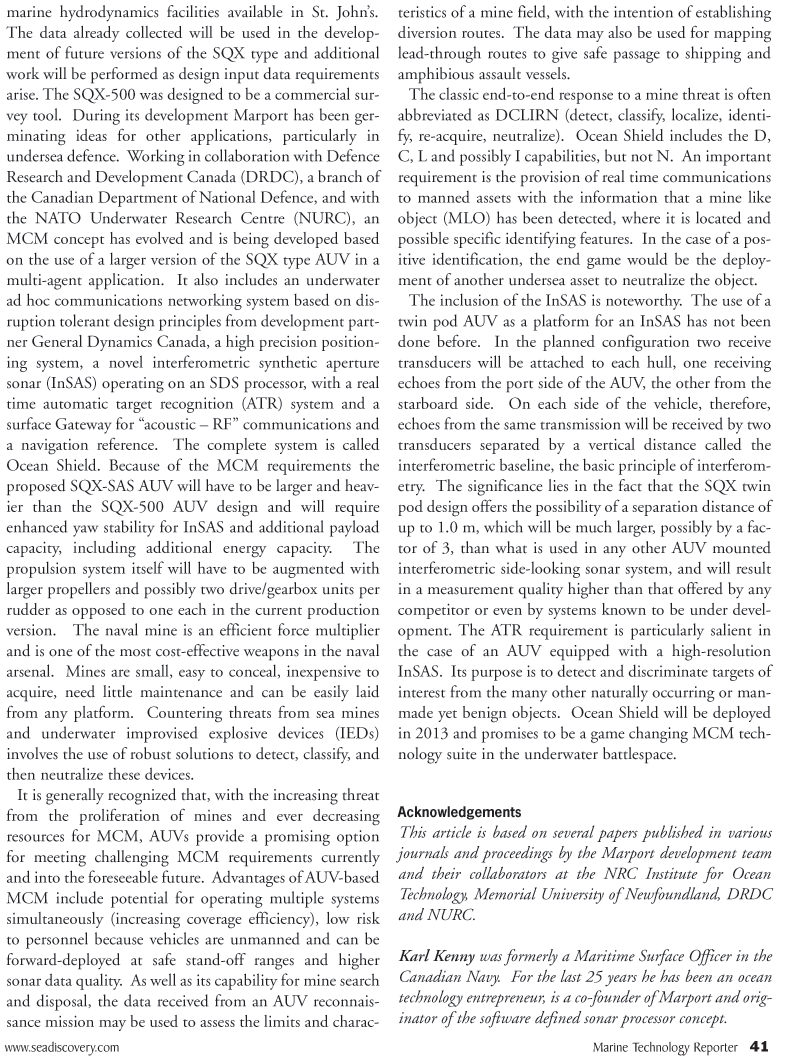
Page 41: of Marine Technology Magazine (May 2011)
Subsea Defense Edition
Read this page in Pdf, Flash or Html5 edition of May 2011 Marine Technology Magazine
www.seadiscovery.com Marine Technology Reporter 41 marine hydrodynamics facilities available in St. John’s.
The data already collected will be used in the develop- ment of future versions of the SQX type and additional work will be performed as design input data requirements arise. The SQX-500 was designed to be a commercial sur- vey tool. During its development Marport has been ger- minating ideas for other applications, particularly in undersea defence. Working in collaboration with Defence
Research and Development Canada (DRDC), a branch of the Canadian Department of National Defence, and with the NATO Underwater Research Centre (NURC), an
MCM concept has evolved and is being developed based on the use of a larger version of the SQX type AUV in a multi-agent application. It also includes an underwater ad hoc communications networking system based on dis- ruption tolerant design principles from development part- ner General Dynamics Canada, a high precision position- ing system, a novel interferometric synthetic aperture sonar (InSAS) operating on an SDS processor, with a real time automatic target recognition (ATR) system and a surface Gateway for “acoustic – RF” communications and a navigation reference. The complete system is called
Ocean Shield. Because of the MCM requirements the proposed SQX-SAS AUV will have to be larger and heav- ier than the SQX-500 AUV design and will require enhanced yaw stability for InSAS and additional payload capacity, including additional energy capacity. The propulsion system itself will have to be augmented with larger propellers and possibly two drive/gearbox units per rudder as opposed to one each in the current production version. The naval mine is an efficient force multiplier and is one of the most cost-effective weapons in the naval arsenal. Mines are small, easy to conceal, inexpensive to acquire, need little maintenance and can be easily laid from any platform. Countering threats from sea mines and underwater improvised explosive devices (IEDs) involves the use of robust solutions to detect, classify, and then neutralize these devices.
It is generally recognized that, with the increasing threat from the proliferation of mines and ever decreasing resources for MCM, AUVs provide a promising option for meeting challenging MCM requirements currently and into the foreseeable future. Advantages of AUV-based
MCM include potential for operating multiple systems simultaneously (increasing coverage efficiency), low risk to personnel because vehicles are unmanned and can be forward-deployed at safe stand-off ranges and higher sonar data quality. As well as its capability for mine search and disposal, the data received from an AUV reconnais- sance mission may be used to assess the limits and charac- teristics of a mine field, with the intention of establishing diversion routes. The data may also be used for mapping lead-through routes to give safe passage to shipping and amphibious assault vessels.
The classic end-to-end response to a mine threat is often abbreviated as DCLIRN (detect, classify, localize, identi- fy, re-acquire, neutralize). Ocean Shield includes the D,
C, L and possibly I capabilities, but not N. An important requirement is the provision of real time communications to manned assets with the information that a mine like object (MLO) has been detected, where it is located and possible specific identifying features. In the case of a pos- itive identification, the end game would be the deploy- ment of another undersea asset to neutralize the object.
The inclusion of the InSAS is noteworthy. The use of a twin pod AUV as a platform for an InSAS has not been done before. In the planned configuration two receive transducers will be attached to each hull, one receiving echoes from the port side of the AUV, the other from the starboard side. On each side of the vehicle, therefore, echoes from the same transmission will be received by two transducers separated by a vertical distance called the interferometric baseline, the basic principle of interferom- etry. The significance lies in the fact that the SQX twin pod design offers the possibility of a separation distance of up to 1.0 m, which will be much larger, possibly by a fac- tor of 3, than what is used in any other AUV mounted interferometric side-looking sonar system, and will result in a measurement quality higher than that offered by any competitor or even by systems known to be under devel- opment. The ATR requirement is particularly salient in the case of an AUV equipped with a high-resolution
InSAS. Its purpose is to detect and discriminate targets of interest from the many other naturally occurring or man- made yet benign objects. Ocean Shield will be deployed in 2013 and promises to be a game changing MCM tech- nology suite in the underwater battlespace.
Acknowledgements
This article is based on several papers published in various journals and proceedings by the Marport development team and their collaborators at the NRC Institute for Ocean
Technology, Memorial University of Newfoundland, DRDC and NURC.
Karl Kenny was formerly a Maritime Surface Officer in the
Canadian Navy. For the last 25 years he has been an ocean technology entrepreneur, is a co-founder of Marport and orig- inator of the software defined sonar processor concept.

 40
40

 42
42
